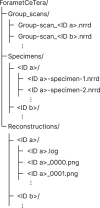ForametCeTera, a novel CT scan dataset to expedite classification research of (non-)foraminifera
- PMID: 38886446
- PMCID: PMC11183234
- DOI: 10.1038/s41597-024-03476-w
ForametCeTera, a novel CT scan dataset to expedite classification research of (non-)foraminifera
Abstract
This paper introduces ForametCeTera, a pioneering dataset designed to address the challenges associated with automating the analysis of benthic foraminifera in sediment cores. Foraminifera are sensitive sentinels of environmental change and are a crucial component of carbonate-denominated ecosystems, such as coral reefs. Studying their prevalence and characteristics is imperative in understanding climate change. However, analysis of foraminifera contained in core samples currently requires washing, sieving and manual quantification. These methods are thus time-consuming and require trained experts. To overcome these limitations, we propose an alternative workflow utilizing 3D X-ray computational tomography (CT) for fully automated analysis, saving time and resources. Despite recent advancements in automation, a crucial lack of methods persists for segmenting and classifying individual foraminifera from 3D scans. In response, we present ForametCeTera, a diverse dataset featuring 436 3D CT scans of individual foraminifera and non-foraminiferan material following a high-throughput scanning workflow. ForametCeTera serves as a foundational resource for generating synthetic digital core samples, facilitating the development of segmentation and classification methods of entire core sample CT scans.
© 2024. The Author(s).
Conflict of interest statement
The authors declare no competing interests.
Figures





References
-
- Dawson J, Smithers S, Hua Q. The importance of large benthic foraminifera to reef island sediment budget and dynamics at Raine Island, northern Great Barrier Reef. Geomorphology. 2014;222:68–71. doi: 10.1016/j.geomorph.2014.03.023. - DOI
-
- Doo, S., Hamylton, S., Finfer, J. & Byrne, M. Spatial and temporal variation in reef-scale carbonate storage of large benthic foraminifera: a case study on One Tree Reef. Faculty of Science, Medicine and Health - Papers: part A 293–303, 10.1007/s00338-016-1506-0 (2017).
-
- Perry CT, Spencer T, Kench PS. Carbonate budgets and reef production states: a geomorphic perspective on the ecological phase-shift concept. Coral Reefs. 2008;27:853–866. doi: 10.1007/s00338-008-0418-z. - DOI
-
- Browne, N. K. et al. Predicting Responses of Geo-ecological Carbonate Reef Systems to Climate Change: A Conceptual Model and Review. In Hawkins, S. J. et al. (1st edn.) Oceanography and Marine Biology, 229–370, 10.1201/9781003138846-4 (CRC Press, Boca Raton, 1st edn, 2021).

